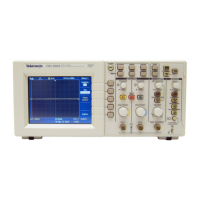Do you have a question about the Tektronix TDS2000C series and is the answer not in the manual?
| Brand | Tektronix |
|---|---|
| Model | TDS2000C series |
| Category | Test Equipment |
| Language | English |
Safety precautions for avoiding injury and product damage during operation and handling.
Lists EMC standards and declarations of conformity for electromagnetic compatibility.
Details safety compliance standards, testing laboratories, and certifications.
Provides information on product end-of-life handling, recycling, and hazardous substances.
Explains how to use the oscilloscope's built-in help system for information retrieval.
Describes the manual's conventions for menu options, buttons, and symbols used throughout.
Lists and describes the general features and models of the oscilloscopes.
Provides instructions on installing the product, including power cord and security.
Guides the user through a functional check to verify oscilloscope operation.
Covers safety precautions and warnings related to using oscilloscope probes.
Verifies voltage probe operation and guides compensation adjustment.
Explains manual adjustment for matching probe to the input channel.
Details selecting probe attenuation factors to match the oscilloscope.
Guides setting the oscilloscope scale to match the current probe.
Describes the self-calibration routine for optimizing measurement accuracy.
Overview of the display area, menu system, and front-panel controls.
Describes input connectors and other front-panel items like USB ports.
Introduces key functions like Autoset, Autorange, saving, and recalling setups.
Explains how trigger settings control waveform acquisition and display stability.
Details acquisition modes (Sample, Peak Detect, Average) and time base settings.
Guides on quickly displaying and measuring signal amplitude and frequency.
Details using the Measure menu for automatic signal parameter measurements.
Guides on using cursors for precise time and amplitude measurements.
Covers triggering on pulse widths, video signals, and video lines for stable displays.
Explains configuring and using the data logging feature to record signals over time.
Details setting up limit tests to compare signals against templates.
Guides on preparing the time-domain waveform for FFT analysis.
Explains how to select source, window, and zoom for displaying the FFT spectrum.
Guides on using cursors to measure magnitude and frequency in FFT spectrums.
Covers connecting, formatting, and managing files on USB flash drives.
Details methods for saving and recalling setups, images, and waveforms using USB drives.
Covers installing PC software, connecting to PCs, GPIB, and printers.
Details acquisition modes (Sample, Peak Detect, Average) and their settings.
Explains how Autorange automatically adjusts settings for signal tracking.
Describes how Autoset identifies waveforms and adjusts controls for optimal display.
Explains trigger types (Edge, Video, Pulse Width) and their settings.
Details performing self-calibration for accurate measurements under varying temperatures.
Covers file management tasks on USB flash drives like selecting, renaming, and formatting.
Details input characteristics like voltage, CMRR, and crosstalk.
Provides specifications for vertical settings like sensitivity, resolution, and accuracy.
Details trigger sensitivities, ranges, accuracy, and modes.
Guides on connecting probes to the oscilloscope and compensating them for accurate measurements.
Lists standard and optional accessories and their electrical/environmental specifications.
Outlines critical safety precautions for using probes and accessories.
Provides guidelines for general care and cleaning of the oscilloscope and probes.
Lists the default settings for buttons and controls when the Default Setup button is pressed.











